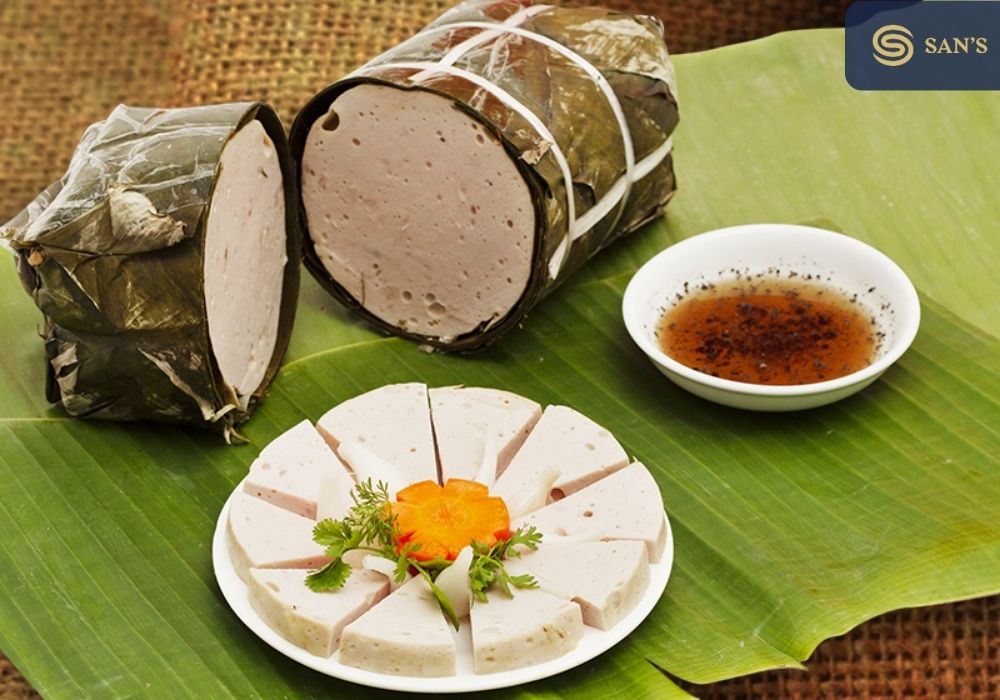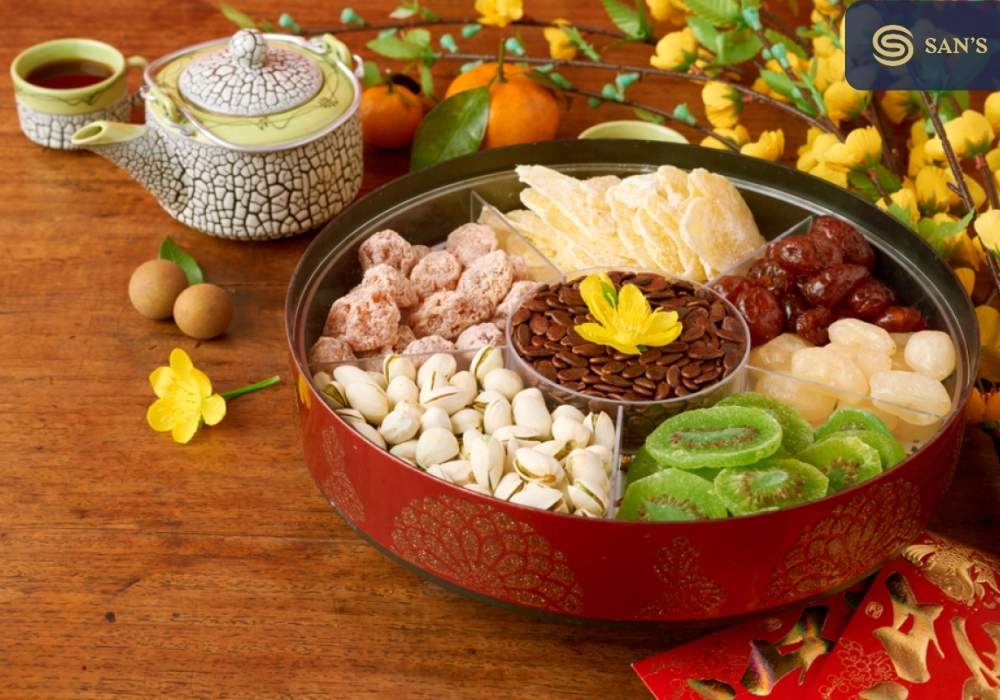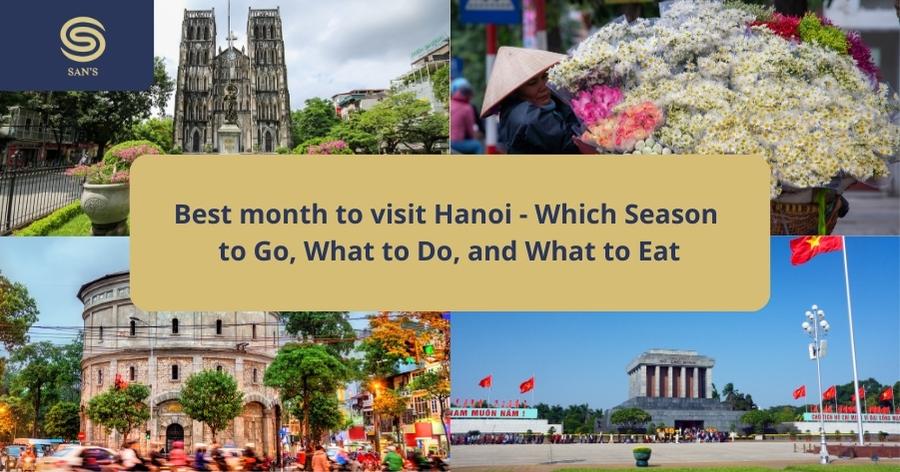Tet, Vietnam’s most significant holiday, is a time of joy, renewal, and festivity. This celebration marks the Lunar New Year and is deeply ingrained in the Vietnamese cultural identity. Central to the Tet festivities is the culinary tradition, where certain dishes are not only feasts for the taste buds but also carry profound cultural significance. In this article, we explore the essential foods for Tet in Vietnam, delving into the flavors and traditions that make these dishes integral to the Lunar New Year celebrations.
Banh Chung and Banh Tet: The Quintessential Tet Foods

At the heart of Tet, the Vietnamese Lunar New Year, are Banh Chung and Banh Tet, considered the most essential foods for Tet in Vietnam. These traditional rice cakes have a history as rich as their flavors, deeply intertwined with Vietnamese legends and traditions.
Banh Chung, the square-shaped cake, symbolizes the Earth, while Banh Tet, the cylindrical version, represents the Moon. Both are made from glutinous rice, mung beans, and pork, and are wrapped in banana leaves, embodying the respect for nature prevalent in Vietnamese culture.
Over time, these quintessential Tet foods have seen regional variations and modern adaptations. From differences in fillings to variations in cooking methods, these changes reflect the evolving palate of the Vietnamese people while maintaining the symbolic essence of these dishes.
Whether enjoyed in their traditional form or through contemporary interpretations, Banh Chung and Banh Tet remain central to the celebration of Tet, making them truly essential foods for Tet in Vietnam.
Thit Kho Tau (Caramelized Pork and Eggs)
-

Thit kho tau – essential foods for Tet in Vietnam
Thit Kho Tau, a dish of caramelized pork and eggs, stands out as one of the essential foods for Tet in Vietnam. This savory dish is much more than a culinary delight; it is steeped in cultural significance and symbolism. Made with succulent pork belly and eggs slowly simmered in a sweet and savory caramel sauce, Thit Kho Tau is a staple at Tet celebrations, symbolizing wealth, prosperity, and the full circle of life.
The cultural relevance of this dish during Tet is profound. It is often prepared in large quantities to be shared among family and friends, embodying the spirit of generosity and family unity. The eggs, a symbol of fertility and renewal, paired with the richness of the pork, represent the hopes for a prosperous and fruitful year ahead.
The preparation and enjoyment of Thit Kho Tau during Tet is a cherished tradition, making it one of the essential foods for Tet in Vietnam and a meaningful expression of love and togetherness.
Gio Lua (Vietnamese Pork Sausage)
-

Gio lua – essential foods for Tet in Vietnam
Gio Lua, often known as Vietnamese pork sausage, is a delicacy that plays a significant role in the Tet feast, making it one of the essential foods for Tet in Vietnam. This finely ground, tightly wrapped sausage is known for its delicate texture and subtle flavors, embodying the artistry of Vietnamese culinary traditions.
The making of Gio Lua is a meticulous process. It involves finely grounding lean pork, which is then seasoned, wrapped tightly in banana leaves, and boiled to perfection. This process not only ensures the unique, smooth texture of the sausage but also symbolizes the care and attention that goes into preparing food for loved ones during Tet.
In terms of serving, Gio Lua is typically sliced and served alongside other Tet dishes such as Banh Chung or Banh Tet. It pairs wonderfully with pickled vegetables, adding a refreshing crunch and tang to balance its mild flavor. Gio Lua’s versatility in pairings and its delightful taste make it a staple at Tet feasts and solidify its status as one of the essential foods for Tet in Vietnam.
Mut (Candied Fruits)
-

Mut – essential foods for Tet in Vietnam
Mut, or candied fruits, are an indispensable part of the Tet festival, earning their place as one of the essential foods for Tet in Vietnam. These sweet delicacies are more than just treats; they symbolize the wish for a sweet and prosperous life in the coming year. The variety of Mut is a testament to the richness of Vietnamese cuisine, featuring an array of fruits such as coconut, ginger, tamarind, and lotus seeds, each offering its unique flavor and texture.
The significance of Mut in Tet celebrations extends beyond its taste. Preparing these candied fruits is a cherished tradition, often involving the whole family. The traditional method of preparation is a time-honored process that requires skill and patience.
Fruits are carefully selected, sliced, and then slowly candied in sugar syrup until they achieve the perfect balance of sweetness and texture. This process not only preserves the fruits but also infuses them with a delightful sweetness, making them a favorite treat during Tet.
Enjoying Mut during Tet is a way of savoring the sweetness of the past year and welcoming the new year with optimism and joy. Thus, Mut holds a special place in the heart of Tet festivities, rightfully considered one of the essential foods for Tet in Vietnam.
Xoi Gac (Red Sticky Rice)
-

Xoi gac – essential foods for Tet in Vietnam
Xoi Gac, or red sticky rice, is a vibrant and meaningful dish that is counted among the essential foods for Tet in Vietnam. The dish’s striking red color, derived from the Gac fruit, is not just visually appealing but also carries deep symbolism in Tet celebrations. Red in Vietnamese culture is considered auspicious, symbolizing good fortune, happiness, and prosperity. Therefore, Xoi Gac is much more than a culinary item; it’s a symbol of the wishes for a prosperous and lucky new year.
Preparing Xoi Gac is a process steeped in tradition. The key ingredient, Gac fruit, is known for its bright red color and is typically harvested just in time for the Tet festival. To make the dish, the aril of the Gac fruit is mixed with glutinous rice, imparting its vibrant hue and subtle flavor. The mixture is then steamed until the rice becomes tender and sticky, resulting in a visually striking and deliciously festive dish.
Serving Xoi Gac during Tet is a way to honor tradition and bring a sense of joy and optimism to the New Year’s celebrations. Its presence on the Tet table is not only a feast for the eyes but also a heartfelt expression of good wishes for the year ahead, making Xoi Gac a cherished part of the essential foods for Tet in Vietnam.
Canh Mang (Bamboo Shoot Soup)
-

Canh mang – essential foods for Tet in Vietnam
Canh Mang, a bamboo shoot soup, is a traditional dish that holds a special place as one of the essential foods for Tet in Vietnam. This soup is often consumed during Tet as it is believed to symbolize a fresh and auspicious start to the new year. The bamboo shoots represent resilience and strength, qualities that are highly valued and wished for in the upcoming year.
The recipe for Canh Mang varies across different regions in Vietnam, showcasing the diversity of Vietnamese culinary practices. In the northern regions, the soup is typically prepared with a clear broth, featuring bamboo shoots and a choice of meat like chicken or pork.
In the southern parts, it might include additional ingredients like shrimp or fish balls, giving it a more complex flavor profile. Despite these regional variations, the essence of Canh Mang remains the same – a light, refreshing soup that cleanses the palate and rejuvenates the spirit.
The importance of Canh Mang during Tet cannot be overstated. It not only adds variety and balance to the rich Tet feast but also carries with it the hope for a year filled with health, strength, and growth. As such, it is rightfully considered one of the essential foods for Tet in Vietnam, embodying both the flavors and aspirations of the Vietnamese Lunar New Year.
Banh Tet La Cam (Purple Tet Cake)

Banh Tet La Cam is a modern variation of the traditional Banh Tet and has quickly become one of the essential foods for Tet in Vietnam. This version of the cake introduces a creative twist by incorporating the natural purple color derived from the magenta plant, giving it a distinctive and visually appealing appearance.
The purple color in Banh Tet La Cam is not just for aesthetic purposes; it carries its own cultural significance. In Vietnamese culture, purple is often associated with royalty, wealth, and prosperity. By integrating this color into Banh Tet, a traditional food for the Lunar New Year, the dish takes on a deeper meaning, symbolizing the aspiration for affluence and success in the coming year.
Despite its modern adaptation, Banh Tet La Cam stays true to the traditional preparation methods of Banh Tet. The cake is made from glutinous rice, filled with mung bean paste and pork, then wrapped in banana leaves and steamed. The addition of the magenta plant’s natural color to the rice adds an interesting and meaningful dimension to this traditional dish, making it a delightful and symbolic part of the essential foods for Tet in Vietnam.
Dua Hanh (Pickled Onions)

Dua Hanh, or pickled onions, play an integral role in balancing the rich and hearty dishes typically found in the Tet feast, making them one of the essential foods for Tet in Vietnam. This simple yet flavorful side dish is known for its crisp texture and tangy taste, providing a refreshing contrast to the heavier, more savory flavors of other traditional Tet foods.
The role of Dua Hanh in the Tet feast is crucial. Its acidity and crispness cut through the richness of dishes like Thit Kho Tau (caramelized pork and eggs) and Banh Chung (sticky rice cake), aiding in digestion and enhancing the overall dining experience. This balance is important in Vietnamese cuisine, emphasizing not just the taste but also the harmony of different flavors and textures in a meal.
Homemade pickling techniques for Dua Hanh are straightforward yet effective. The process typically involves slicing small onions or shallots and then pickling them in a mixture of vinegar, sugar, and water. Some recipes might include additional spices like ginger or chili for an extra kick.
The onions are left to marinate for at least a few days, allowing the flavors to develop fully. The result is a crisp, tangy, and slightly sweet condiment that no Tet feast is complete without. As such, Dua Hanh rightfully earns its place among the essential foods for Tet in Vietnam, complementing the flavors of the
Che Kho (Mung Bean Pudding)

Che Kho, a traditional mung bean pudding, is revered as one of the essential foods for Tet in Vietnam. This dessert stands out for its simplicity and sweetness, embodying the essence of Tet’s culinary traditions. Made primarily from mung beans and sugar, Che Kho has a soft, comforting texture and a subtly sweet flavor, making it a favorite end to the festive meals of Tet.
Che Kho’s sweetness and ease of preparation make it a beloved treat during Tet, enjoyed by families as a symbol of togetherness and hope for a prosperous year ahead. Its presence on the Tet table is a testament to the traditions and flavors of Vietnam, solidifying its status as one of the essential foods for Tet in Vietnam.





